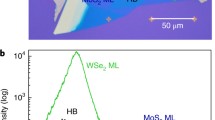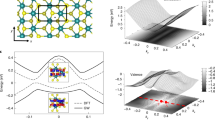Abstract
Monolayer films of transition metal dichalcogenides (in particular, MoS2, MoSe2, WS2, and WSe2) can be considered as ideal systems for the studies of high-temperature electron-hole liquids. The quasi-two-dimensional nature of electrons and holes ensures their stronger interaction as compared to that in bulk semiconductors. The screening of the Coulomb interaction in monolayer heterostructures is significantly reduced, since it is determined by the permittivities of the environment (e.g., vacuum and substrate), which are much lower than those characteristic of the films of transition metal dichalcogenides. The multivalley structure of the energy spectrum of charge carriers in transition metal dichalcogenides significantly reduces the kinetic energy, resulting in the increase in the equilibrium density and binding energy of the electron-hole liquid. The binding energy of the electron-hole liquid and its equilibrium density are determined. It is shown that the two-dimensional Coulomb potential should be used in the calculations for the electron-hole liquid.
Similar content being viewed by others
References
P. V. Ratnikov and A. P. Silin, Phys. Usp. 61, 1139 (2018).
P. Miro, M. Audiffred, and T. Heine, Chem. Soc. Rev. 43, 6537 (2014).
A. K. Geim and I. V. Grigorieva, Nature (London, U.K.) 499, 419 (2013).
L. N. Bulaevskii, Sov. Phys. Usp. 18, 514 (1975).
L. N. Bulaevskii, Sov. Phys. Usp. 19, 836 (1976).
M. V. Durnev and M. M. Glazov, Phys. Usp. 61, 825 (2018).
J. A. Wilson and A. D. Yoffe, Adv. Phys. 18, 193 (1969).
V. L. Kalikhman and Ya. S. Umanskii, Sov. Phys. Usp. 15, 728 (1972).
A. P. Silin, Sov. Phys. Solid State 20, 1983 (1978).
L. A. Chernozatonskii and A. A. Artyukh, Phys. Usp. 61, 2 (2018).
Yiling Yu, Yifei Yu, Y. Cai, W. Li, A. Gurarslan, H. Peelaers, D. E. Aspnes, Ch. G. van de Walle, Nh. V. Nguyen, Y.-W. Zhang, and L. Cao, Sci. Rep. 5, 16996 (2016).
E. A. Andryushin, L. V. Keldysh, and A. P. Silin, Sov. Phys. JETP 46, 616 (1977).
T. Rice, J. Hensel, T. Phillips, and G. Thomas, Solid State Phys. 32, 88 (1977).
Electron-Hole Droplets in Semiconductors, Ed. by C. D. Jeffries and L. V. Keldysh (Elsevier Science, Amsterdam, 1983).
S. G. Tikhodeev, Sov. Phys. Usp. 28, 1 (1985).
N. N. Sibeldin, J. Exp. Theor. Phys. 122, 587 (2016).
N. N. Sibeldin, Phys. Usp. 60, 1147 (2017).
Y. Yu, A. W. Bataller, R. Younts, Y. Yu, G. Li, A. A. Puretzky, D. B. Geohegan, K. Gundogdu, and L. Cao, ACS Nano 13, 10351 (2019).
E. A. Andryushin and A. P. Silin, Sov. Phys. Solid State 21, 491 (1979).
E. A. Andryushin, V. S. Babichenko, L. V. Keldysh, T. A. Onishchenko, and A. P. Silin, JETP Lett. 24, 185 (1976).
E. A. Andryushin and A. P. Silin, Sov. Phys. Solid State 18, 1243 (1976).
E. A. Andryushin and A. P. Silin, Solid State Comm. 20, 453 (1976).
N. S. Rytova, Vestn. Mosk. Univ., Ser.: Fiz. Astron., No. 3, 30 (1967).
L. V. Keldysh, JETP Lett. 29, 658 (1979).
A. Rustagi and A. F. Kemper, Nano Lett. 18, 455 (2018).
L. E. Pechenik and A. P. Silin, Kratk. Soobshch. Fiz. FIAN, Nos. 5–6, 72 (1996).
E. A. Andryushin, L. E. Pechenik, and A. P. Silin, Kratk. Soobshch. Fiz. FIAN, Nos. 7–8, 68 (1996).
A. P. Silin and S. V. Shubenkov, Phys. Solid State 42, 24 (2000).
V. S. Babichenko and I. Ya. Polishchuk, JETP Lett. 97, 628 (2013).
A. P. Silin, Kratk. Soobshch. Fiz. FIAN, No. 5, 30 (1983).
M. Combescot and P. Nozieres, J. Phys. C 5, 2369 (1972).
E. A. Andryushin and A. P. Silin, Sov. Phys. Solid State 19, 815 (1977).
T. Eknapakul, P. D. C. King, M. Asakawa, P. Buaphet, R.-H. He, S.-K. Mo, H. Takagi, K. M. Shen, F. Baumberger, T. Sasagawa, S. Jungthawan, and W. Meevasana, Nano Lett. 14, 1312 (2014).
T. C. Berkelbach, M. S. Hybertsen, and D. R. Reichman, Phys. Rev. B 88, 045318 (2013).
Funding
P.V. Ratnikov acknowledges the support of the Foundation for the Advancement of Theoretical Physics and Mathematics BASIS (project no. 17-14-440-1, the general formulation of the problem) and of the Russian Science Foundation (project no. 16-12-10538-P, the calculations of the correlation energy, Section 3).
Author information
Authors and Affiliations
Corresponding author
Additional information
Russian Text © The Author(s), 2020, published in Pis’ma v Zhurnal Eksperimental’noi i Teoreticheskoi Fiziki, 2020, Vol. 111, No. 2, pp. 80-85.
Rights and permissions
About this article
Cite this article
Pekh, P.L., Ratnikov, P.V. & Silin, A.P. Electron-Hole Liquid in Monolayer Transition Metal Dichalcogenide Heterostructures. Jetp Lett. 111, 90–95 (2020). https://doi.org/10.1134/S0021364020020101
Received:
Revised:
Accepted:
Published:
Issue Date:
DOI: https://doi.org/10.1134/S0021364020020101




